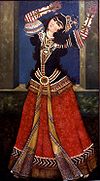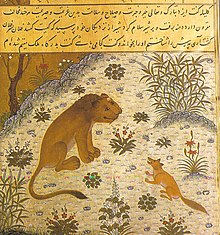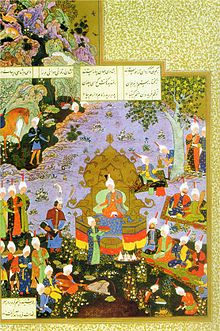 Global Information
Global InformationPersian literature information
| Part of a series on the |
| Culture of Iran |
|---|
 |
|
|
|
|
|
|
|
|
|
|
|
|
| History of literature by era |
|---|
| Ancient (corpora) |
|
| Early medieval |
|
| Medieval by century |
|
| Early modern by century |
|
| Modern by century |
|
| Contemporary by century |
|
|
|


Persian literature[a] comprises oral compositions and written texts in the Persian language and is one of the world's oldest literatures.[1][2][3] It spans over two-and-a-half millennia. Its sources have been within Greater Iran including present-day Iran, Iraq, Afghanistan, the Caucasus, and Turkey, regions of Central Asia (such as Tajikistan), South Asia and the Balkans where the Persian language has historically been either the native or official language. For example, Rumi, one of the best-loved Persian poets, born in Balkh (in modern-day Afghanistan) or Wakhsh (in modern-day Tajikistan), wrote in Persian and lived in Konya (in modern-day Turkey), at that time the capital of the Seljuks in Anatolia. The Ghaznavids conquered large territories in Central and South Asia and adopted Persian as their court language. There is thus Persian literature from Iran, Mesopotamia, Azerbaijan, the wider Caucasus, Turkey, Pakistan, Bangladesh, India, Tajikistan and other parts of Central Asia, as well as the Balkans. Not all Persian literature is written in Persian, as some consider works written by ethnic Persians or Iranians in other languages, such as Greek and Arabic, to be included. At the same time, not all literature written in Persian is written by ethnic Persians or Iranians, as Turkic, Caucasian, Indic and Slavic poets and writers have also used the Persian language in the environment of Persianate cultures.
Described as one of the great literatures of humanity,[4] including Goethe's assessment of it as one of the four main bodies of world literature,[5] Persian literature has its roots in surviving works of Middle Persian and Old Persian, the latter of which dates back as far as 522 BCE, the date of the earliest surviving Achaemenid inscription, the Behistun Inscription. The bulk of surviving Persian literature, however, comes from the times following the Muslim conquest of Persia c. 650 CE. After the Abbasids came to power (750 CE), the Iranians became the scribes and bureaucrats of the Islamic Caliphate and, increasingly, also its writers and poets. The New Persian language literature arose and flourished in Khorasan and Transoxiana because of political reasons, early Iranian dynasties of post-Islamic Iran such as the Tahirids and Samanids being based in Khorasan.[6]
Persian poets such as Ferdowsi, Saadi, Hafiz, Attar, Nezami,[7] Rumi[8] and Omar Khayyam[9][10] are also known in the West and have influenced the literature of many countries.
Cite error: There are <ref group=lower-alpha> tags or {{efn}} templates on this page, but the references will not show without a {{reflist|group=lower-alpha}} template or {{notelist}} template (see the help page).
- ^ Spooner, Brian (1994). "Dari, Farsi, and Tojiki". In Marashi, Mehdi (ed.). Persian Studies in North America: Studies in Honor of Mohammad Ali Jazayery. Leiden: Brill. pp. 177–178. ISBN 9780936347356. Archived from the original on 22 October 2023. Retrieved 12 April 2017.
- ^ Spooner, Brian (2012). "Dari, Farsi, and Tojiki". In Schiffman, Harold (ed.). Language policy and language conflict in Afghanistan and its neighbors: the changing politics of language choice. Leiden: Brill. p. 94. ISBN 978-9004201453. Archived from the original on 22 October 2023. Retrieved 12 April 2017.
- ^ Campbell, George L.; King, Gareth, eds. (2013). "Persian". Compendium of the World's Languages (3rd ed.). Routledge. p. 1339. ISBN 9781136258466. Archived from the original on 22 October 2023. Retrieved 12 April 2017.
- ^ Arthur John Arberry, The Legacy of Persia, Oxford: Clarendon Press, 1953, ISBN 0-19-821905-9, p. 200.
- ^ Von David Levinson; Karen Christensen, Encyclopedia of Modern Asia, Charles Scribner's Sons. 2002, vol. 4, p. 480
- ^ Frye, R.N., "Darī", The Encyclopaedia of Islam, Brill Publications, CD version.
- ^ C. A. (Charles Ambrose) Storey and Franço de Blois (2004), "Persian Literature - A Biobibliographical Survey: Volume V Poetry of the Pre-Mongol Period", RoutledgeCurzon; 2nd revised edition (June 21, 2004). p. 363: "Nizami Ganja’i, whose personal name was Ilyas, is the most celebrated native poet of the Persians after Firdausi. His nisbah designates him as a native of Ganja (Elizavetpol, Kirovabad) in Azerbaijan, then still a country with an Iranian population, and he spent the whole of his life in Transcaucasia; the verse in some of his poetic works which makes him a native of the hinterland of Qom is a spurious interpolation."
- ^ Franklin Lewis, Rumi Past and Present, East and West, Oneworld Publications, 2000. How is it that a Persian boy born almost eight hundred years ago in Khorasan, the northeastern province of greater Iran, in a region that we identify today as Central Asia, but was considered in those days as part of the Greater Persian cultural sphere, wound up in Central Anatolia on the receding edge of the Byzantine cultural sphere, in which is now Turkey, some 1500 miles to the west? (p. 9)
- ^ Grant, Edward (2006). Science and Religion, 400 B.C. to A.D. 1550 From Aristotle to Copernicus. Johns Hopkins University Press. p. 232.
- ^ Naidis, Mark (1972). The Western Tradition A Survey of Western Civilization. Dryden Press. p. 96.